technical specifications FIAT DUCATO 2012 Owner handbook (in English)
[x] Cancel search | Manufacturer: FIAT, Model Year: 2012, Model line: DUCATO, Model: FIAT DUCATO 2012Pages: 287, PDF Size: 4.5 MB
Page 57 of 287
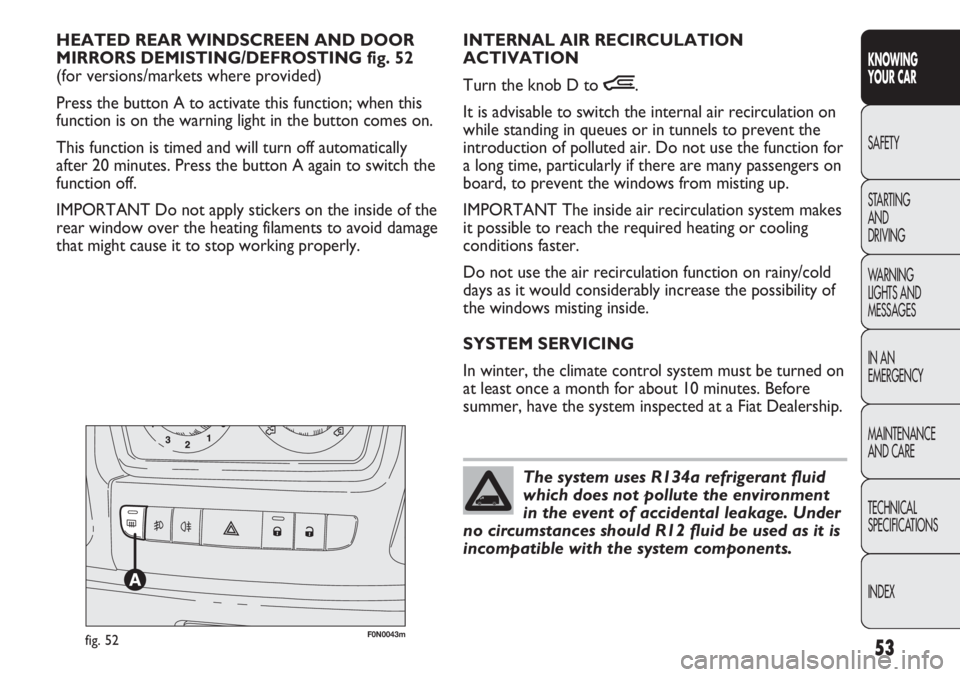
53
KNOWING
YOUR CAR
SAFETY
STARTING
AND
DRIVING
WARNING
LIGHTS AND
MESSAGES
IN AN
EMERGENCY
MAINTENANCE
AND CARE
TECHNICAL
SPECIFICATIONS
INDEX
F0N0043mfig. 52
INTERNAL AIR RECIRCULATION
ACTIVATION
Turn the knob D to
Ò.
It is advisable to switch the internal air recirculation on
while standing in queues or in tunnels to prevent the
introduction of polluted air. Do not use the function for
a long time, particularly if there are many passengers on
board, to prevent the windows from misting up.
IMPORTANT The inside air recirculation system makes
it possible to reach the required heating or cooling
conditions faster.
Do not use the air recirculation function on rainy/cold
days as it would considerably increase the possibility of
the windows misting inside.
SYSTEM SERVICING
In winter, the climate control system must be turned on
at least once a month for about 10 minutes. Before
summer, have the system inspected at a Fiat Dealership. HEATED REAR WINDSCREEN AND DOOR
MIRRORS DEMISTING/DEFROSTING fig. 52
(for versions/markets where provided)
Press the button A to activate this function; when this
function is on the warning light in the button comes on.
This function is timed and will turn off automatically
after 20 minutes. Press the button A again to switch the
function off.
IMPORTANT Do not apply stickers on the inside of the
rear window over the heating filaments to avoid damage
that might cause it to stop working properly.
The system uses R134a refrigerant fluid
which does not pollute the environment
in the event of accidental leakage. Under
no circumstances should R12 fluid be used as it is
incompatible with the system components.
Page 58 of 287
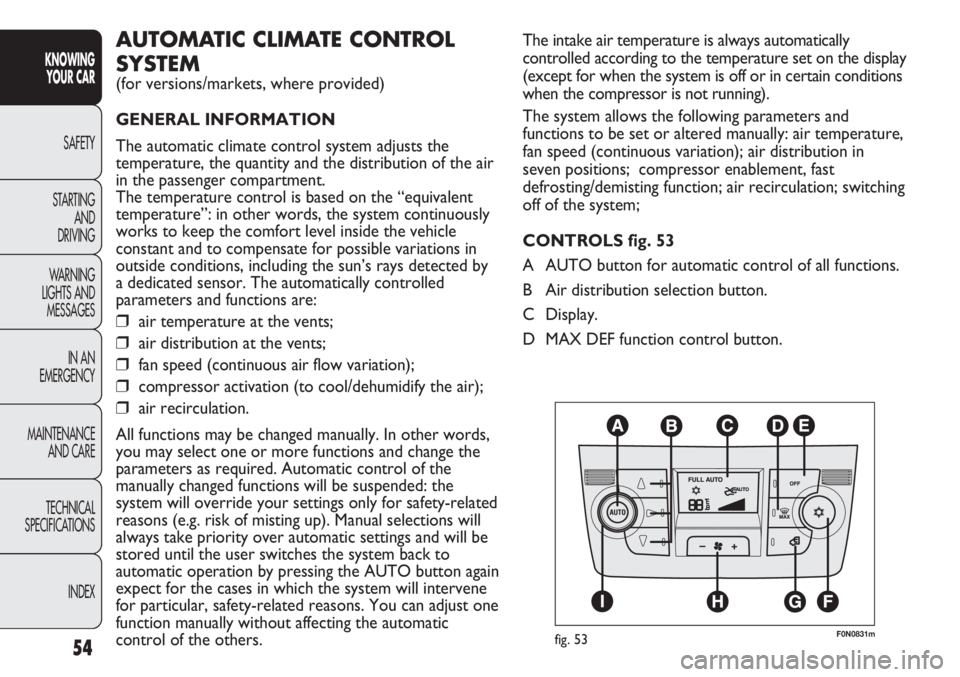
54
KNOWING
YOUR CAR
SAFETY
STARTING
AND
DRIVING
WARNING
LIGHTS AND
MESSAGES
IN AN
EMERGENCY
MAINTENANCE
AND CARE
TECHNICAL
SPECIFICATIONS
INDEX
The intake air temperature is always automatically
controlled according to the temperature set on the display
(except for when the system is off or in certain conditions
when the compressor is not running).
The system allows the following parameters and
functions to be set or altered manually: air temperature,
fan speed (continuous variation); air distribution in
seven positions; compressor enablement, fast
defrosting/demisting function; air recirculation; switching
off of the system;
CONTROLS fig. 53
A AUTO button for automatic control of all functions.
B Air distribution selection button.
C Display.
D MAX DEF function control button.AUTOMATIC CLIMATE CONTROL
SYSTEM
(for versions/markets, where provided)
GENERAL INFORMATION
The automatic climate control system adjusts the
temperature, the quantity and the distribution of the air
in the passenger compartment.
The temperature control is based on the “equivalent
temperature”: in other words, the system continuously
works to keep the comfort level inside the vehicle
constant and to compensate for possible variations in
outside conditions, including the sun’s rays detected by
a dedicated sensor. The automatically controlled
parameters and functions are:
❒air temperature at the vents;
❒air distribution at the vents;
❒fan speed (continuous air flow variation);
❒compressor activation (to cool/dehumidify the air);
❒air recirculation.
All functions may be changed manually. In other words,
you may select one or more functions and change the
parameters as required. Automatic control of the
manually changed functions will be suspended: the
system will override your settings only for safety-related
reasons (e.g. risk of misting up). Manual selections will
always take priority over automatic settings and will be
stored until the user switches the system back to
automatic operation by pressing the AUTO button again
expect for the cases in which the system will intervene
for particular, safety-related reasons. You can adjust one
function manually without affecting the automatic
control of the others.
F0N0831mfig. 53
Page 59 of 287
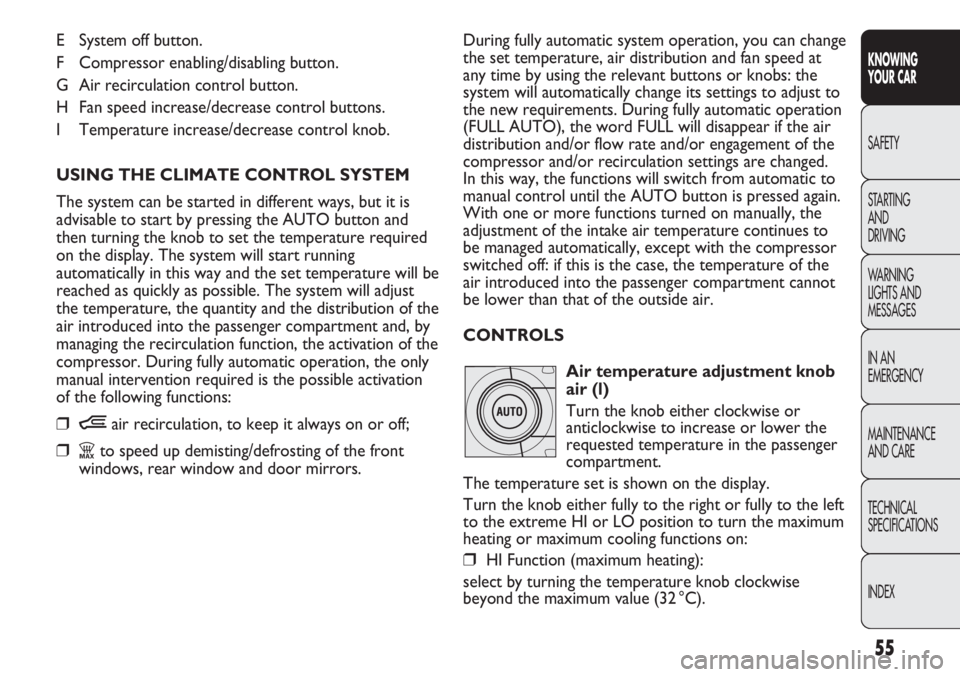
55
KNOWING
YOUR CAR
SAFETY
STARTING
AND
DRIVING
WARNING
LIGHTS AND
MESSAGES
IN AN
EMERGENCY
MAINTENANCE
AND CARE
TECHNICAL
SPECIFICATIONS
INDEX
E System off button.
F Compressor enabling/disabling button.
G Air recirculation control button.
H Fan speed increase/decrease control buttons.
I Temperature increase/decrease control knob.
USING THE CLIMATE CONTROL SYSTEM
The system can be started in different ways, but it is
advisable to start by pressing the AUTO button and
then turning the knob to set the temperature required
on the display. The system will start running
automatically in this way and the set temperature will be
reached as quickly as possible. The system will adjust
the temperature, the quantity and the distribution of the
air introduced into the passenger compartment and, by
managing the recirculation function, the activation of the
compressor. During fully automatic operation, the only
manual intervention required is the possible activation
of the following functions:
❒Òair recirculation, to keep it always on or off;
❒Zto speed up demisting/defrosting of the front
windows, rear window and door mirrors.During fully automatic system operation, you can change
the set temperature, air distribution and fan speed at
any time by using the relevant buttons or knobs: the
system will automatically change its settings to adjust to
the new requirements. During fully automatic operation
(FULL AUTO), the word FULL will disappear if the air
distribution and/or flow rate and/or engagement of the
compressor and/or recirculation settings are changed.
In this way, the functions will switch from automatic to
manual control until the AUTO button is pressed again.
With one or more functions turned on manually, the
adjustment of the intake air temperature continues to
be managed automatically, except with the compressor
switched off: if this is the case, the temperature of the
air introduced into the passenger compartment cannot
be lower than that of the outside air.
CONTROLS
Air temperature adjustment knob
air (l)
Turn the knob either clockwise or
anticlockwise to increase or lower the
requested temperature in the passenger
compartment.
The temperature set is shown on the display.
Turn the knob either fully to the right or fully to the left
to the extreme HI or LO position to turn the maximum
heating or maximum cooling functions on:
❒HI Function (maximum heating):
select by turning the temperature knob clockwise
beyond the maximum value (32 °C).
Page 60 of 287
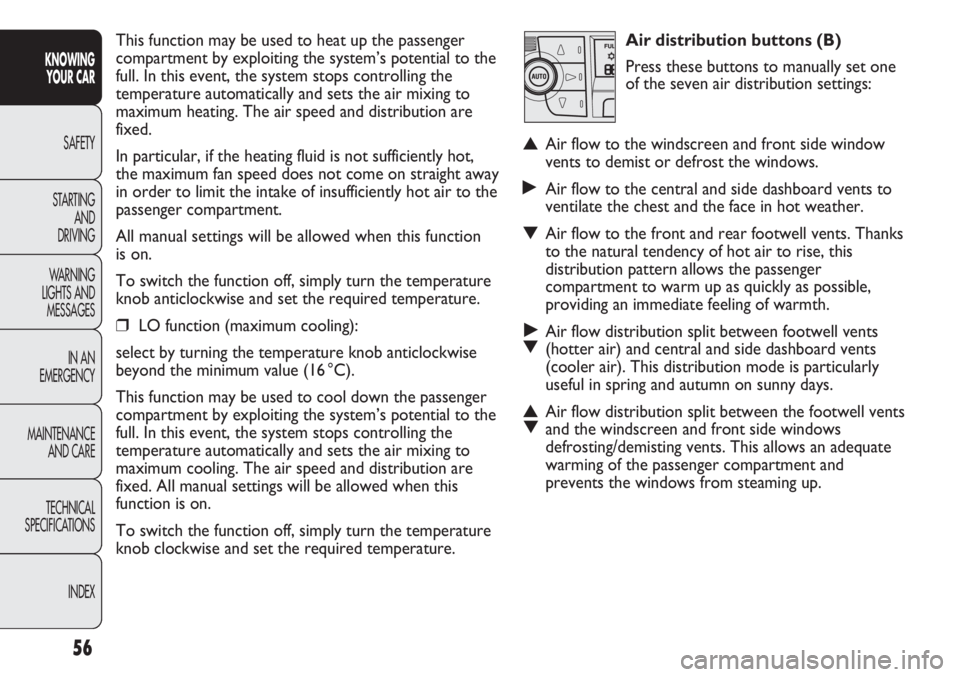
56
KNOWING
YOUR CAR
SAFETY
STARTING
AND
DRIVING
WARNING
LIGHTS AND
MESSAGES
IN AN
EMERGENCY
MAINTENANCE
AND CARE
TECHNICAL
SPECIFICATIONS
INDEX
Air distribution buttons (B)
Press these buttons to manually set one
of the seven air distribution settings:
▲Air flow to the windscreen and front side window
vents to demist or defrost the windows.
˙Air flow to the central and side dashboard vents to
ventilate the chest and the face in hot weather.
▼Air flow to the front and rear footwell vents. Thanks
to the natural tendency of hot air to rise, this
distribution pattern allows the passenger
compartment to warm up as quickly as possible,
providing an immediate feeling of warmth.
˙
▼Air flow distribution split between footwell vents
(hotter air) and central and side dashboard vents
(cooler air). This distribution mode is particularly
useful in spring and autumn on sunny days.
▲
▼Air flow distribution split between the footwell vents
and the windscreen and front side windows
defrosting/demisting vents. This allows an adequate
warming of the passenger compartment and
prevents the windows from steaming up.
This function may be used to heat up the passenger
compartment by exploiting the system’s potential to the
full. In this event, the system stops controlling the
temperature automatically and sets the air mixing to
maximum heating. The air speed and distribution are
fixed.
In particular, if the heating fluid is not sufficiently hot,
the maximum fan speed does not come on straight away
in order to limit the intake of insufficiently hot air to the
passenger compartment.
All manual settings will be allowed when this function
is on.
To switch the function off, simply turn the temperature
knob anticlockwise and set the required temperature.
❒LO function (maximum cooling):
select by turning the temperature knob anticlockwise
beyond the minimum value (16 °C).
This function may be used to cool down the passenger
compartment by exploiting the system’s potential to the
full. In this event, the system stops controlling the
temperature automatically and sets the air mixing to
maximum cooling. The air speed and distribution are
fixed. All manual settings will be allowed when this
function is on.
To switch the function off, simply turn the temperature
knob clockwise and set the required temperature.
Page 61 of 287
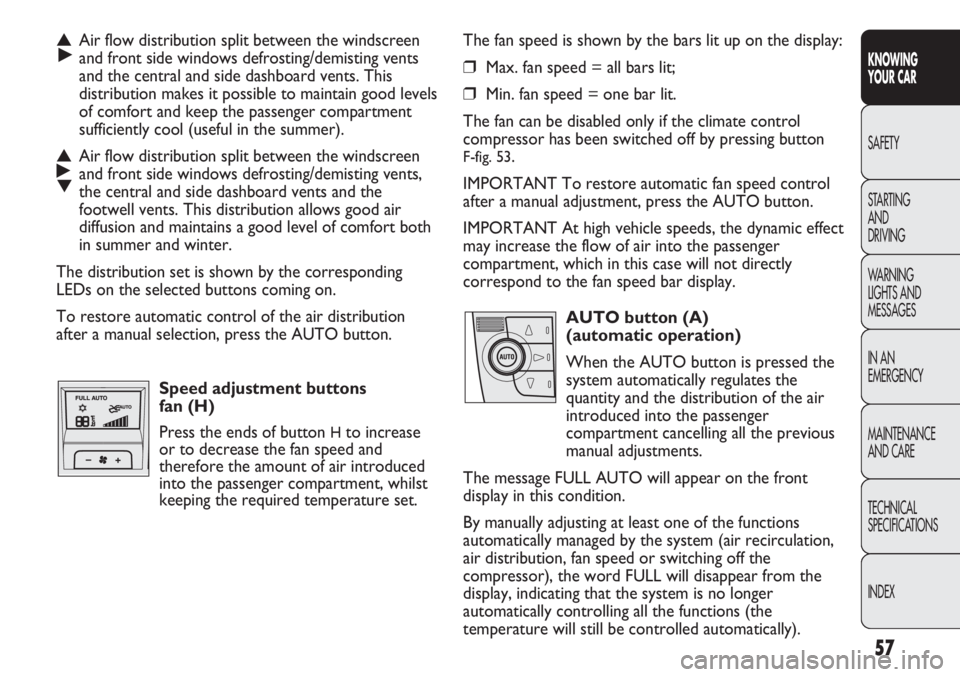
57
KNOWING
YOUR CAR
SAFETY
STARTING
AND
DRIVING
WARNING
LIGHTS AND
MESSAGES
IN AN
EMERGENCY
MAINTENANCE
AND CARE
TECHNICAL
SPECIFICATIONS
INDEX
The fan speed is shown by the bars lit up on the display:
❒Max. fan speed = all bars lit;
❒Min. fan speed = one bar lit.
The fan can be disabled only if the climate control
compressor has been switched off by pressing button
F-fig. 53.
IMPORTANT To restore automatic fan speed control
after a manual adjustment, press the AUTO button.
IMPORTANT At high vehicle speeds, the dynamic effect
may increase the flow of air into the passenger
compartment, which in this case will not directly
correspond to the fan speed bar display.
AUTO button (A)
(automatic operation)
When the AUTO button is pressed the
system automatically regulates the
quantity and the distribution of the air
introduced into the passenger
compartment cancelling all the previous
manual adjustments.
The message FULL AUTO will appear on the front
display in this condition.
By manually adjusting at least one of the functions
automatically managed by the system (air recirculation,
air distribution, fan speed or switching off the
compressor), the word FULL will disappear from the
display, indicating that the system is no longer
automatically controlling all the functions (the
temperature will still be controlled automatically).
▲
˙Air flow distribution split between the windscreen
and front side windows defrosting/demisting vents
and the central and side dashboard vents. This
distribution makes it possible to maintain good levels
of comfort and keep the passenger compartment
sufficiently cool (useful in the summer).
▲
˙
▼Air flow distribution split between the windscreen
and front side windows defrosting/demisting vents,
the central and side dashboard vents and the
footwell vents. This distribution allows good air
diffusion and maintains a good level of comfort both
in summer and winter.
The distribution set is shown by the corresponding
LEDs on the selected buttons coming on.
To restore automatic control of the air distribution
after a manual selection, press the AUTO button.
Speed adjustment buttons
fan (H)
Press the ends of button
Hto increase
or to decrease the fan speed and
therefore the amount of air introduced
into the passenger compartment, whilst
keeping the required temperature set.
Page 62 of 287
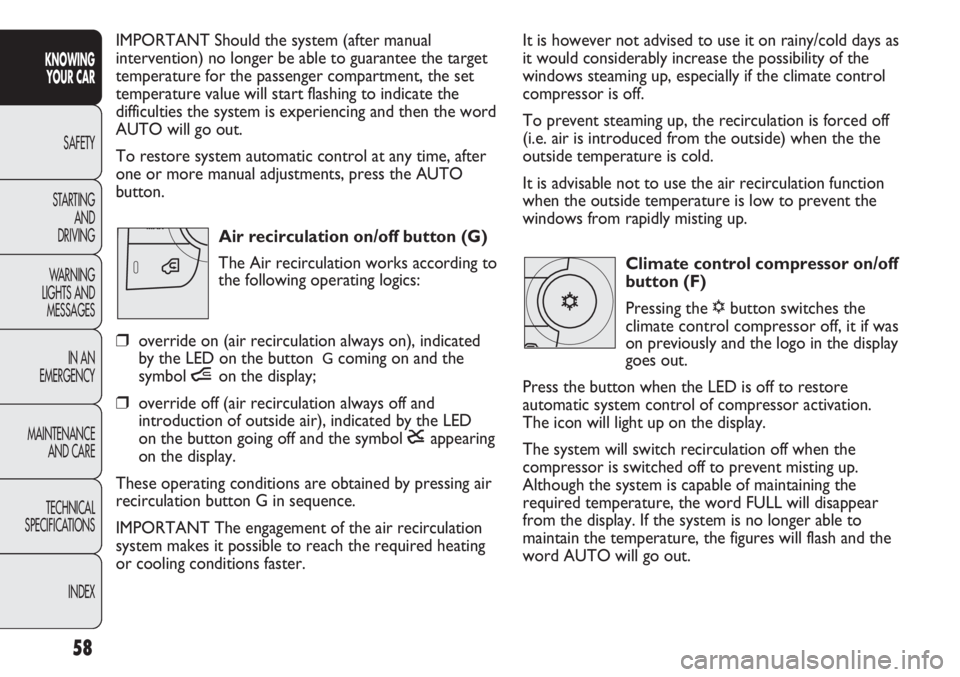
58
KNOWING
YOUR CAR
SAFETY
STARTING
AND
DRIVING
WARNING
LIGHTS AND
MESSAGES
IN AN
EMERGENCY
MAINTENANCE
AND CARE
TECHNICAL
SPECIFICATIONS
INDEX
It is however not advised to use it on rainy/cold days as
it would considerably increase the possibility of the
windows steaming up, especially if the climate control
compressor is off.
To prevent steaming up, the recirculation is forced off
(i.e. air is introduced from the outside) when the the
outside temperature is cold.
It is advisable not to use the air recirculation function
when the outside temperature is low to prevent the
windows from rapidly misting up.
Climate control compressor on/off
button (F)
Pressing the √button switches the
climate control compressor off, it if was
on previously and the logo in the display
goes out.
Press the button when the LED is off to restore
automatic system control of compressor activation.
The icon will light up on the display.
The system will switch recirculation off when the
compressor is switched off to prevent misting up.
Although the system is capable of maintaining the
required temperature, the word FULL will disappear
from the display. If the system is no longer able to
maintain the temperature, the figures will flash and the
word AUTO will go out. IMPORTANT Should the system (after manual
intervention) no longer be able to guarantee the target
temperature for the passenger compartment, the set
temperature value will start flashing to indicate the
difficulties the system is experiencing and then the word
AUTO will go out.
To restore system automatic control at any time, after
one or more manual adjustments, press the AUTO
button.
Air recirculation on/off button (G)
The Air recirculation works according to
the following operating logics:
❒override on (air recirculation always on), indicated
by the LED on the button
Gcoming on and the
symbol íon the display;
❒override off (air recirculation always off and
introduction of outside air), indicated by the LED
on the button going off and the symbol êappearing
on the display.
These operating conditions are obtained by pressing air
recirculation button G in sequence.
IMPORTANT The engagement of the air recirculation
system makes it possible to reach the required heating
or cooling conditions faster.
Page 63 of 287
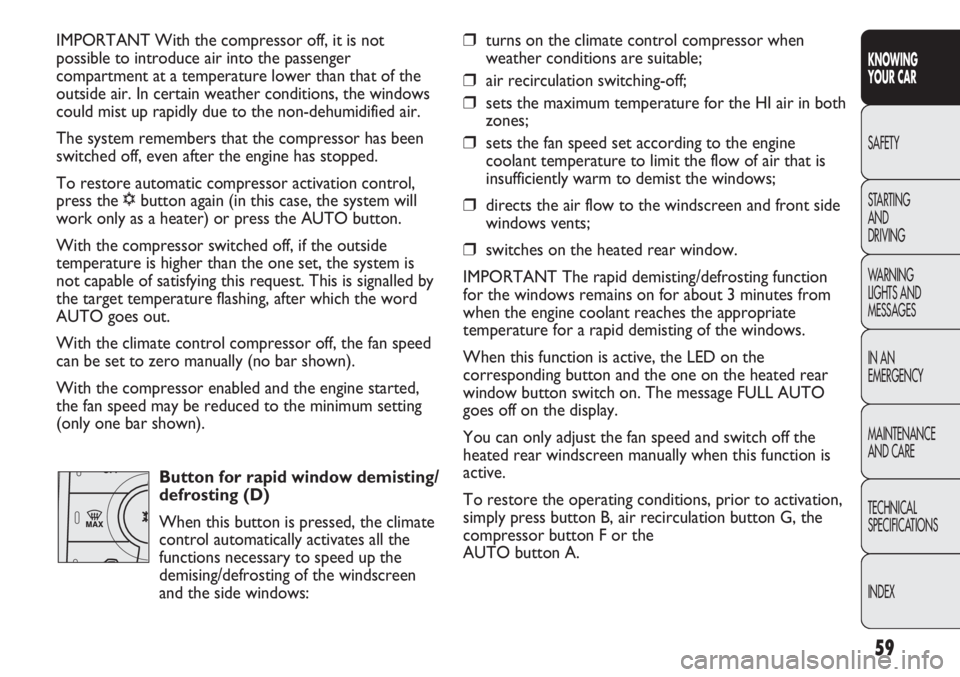
59
KNOWING
YOUR CAR
SAFETY
STARTING
AND
DRIVING
WARNING
LIGHTS AND
MESSAGES
IN AN
EMERGENCY
MAINTENANCE
AND CARE
TECHNICAL
SPECIFICATIONS
INDEX
IMPORTANT With the compressor off, it is not
possible to introduce air into the passenger
compartment at a temperature lower than that of the
outside air. In certain weather conditions, the windows
could mist up rapidly due to the non-dehumidified air.
The system remembers that the compressor has been
switched off, even after the engine has stopped.
To restore automatic compressor activation control,
press the √button again (in this case, the system will
work only as a heater) or press the AUTO button.
With the compressor switched off, if the outside
temperature is higher than the one set, the system is
not capable of satisfying this request. This is signalled by
the target temperature flashing, after which the word
AUTO goes out.
With the climate control compressor off, the fan speed
can be set to zero manually (no bar shown).
With the compressor enabled and the engine started,
the fan speed may be reduced to the minimum setting
(only one bar shown).
Button for rapid window demisting/
defrosting (D)
When this button is pressed, the climate
control automatically activates all the
functions necessary to speed up the
demising/defrosting of the windscreen
and the side windows:❒turns on the climate control compressor when
weather conditions are suitable;
❒air recirculation switching-off;
❒sets the maximum temperature for the HI air in both
zones;
❒sets the fan speed set according to the engine
coolant temperature to limit the flow of air that is
insufficiently warm to demist the windows;
❒directs the air flow to the windscreen and front side
windows vents;
❒switches on the heated rear window.
IMPORTANT The rapid demisting/defrosting function
for the windows remains on for about 3 minutes from
when the engine coolant reaches the appropriate
temperature for a rapid demisting of the windows.
When this function is active, the LED on the
corresponding button and the one on the heated rear
window button switch on. The message FULL AUTO
goes off on the display.
You can only adjust the fan speed and switch off the
heated rear windscreen manually when this function is
active.
To restore the operating conditions, prior to activation,
simply press button B, air recirculation button G, the
compressor button F or the
AUTO button A.
Page 64 of 287
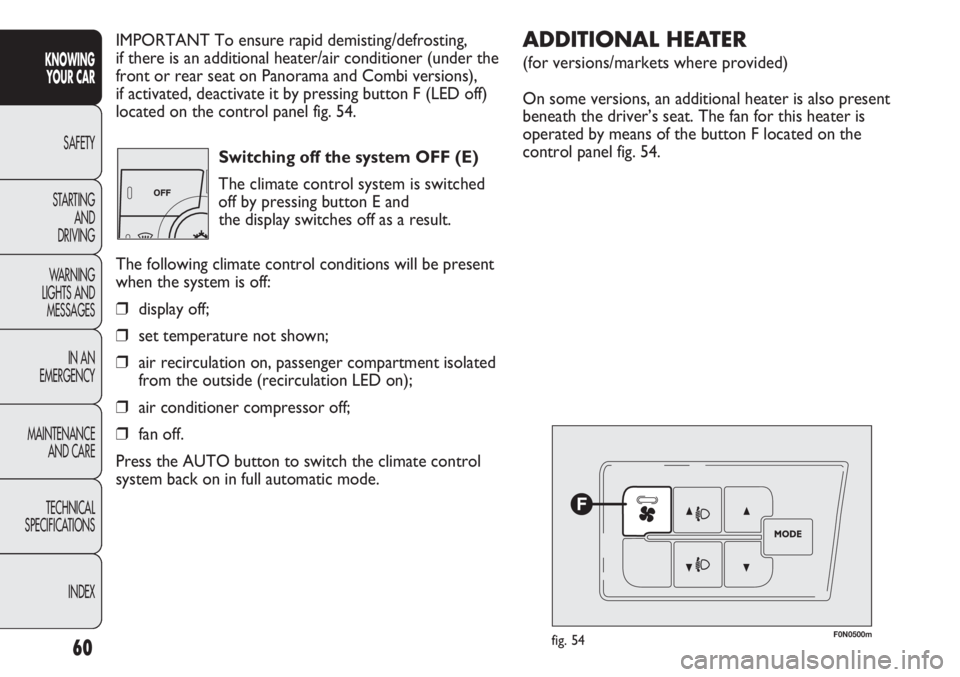
60
KNOWING
YOUR CAR
SAFETY
STARTING
AND
DRIVING
WARNING
LIGHTS AND
MESSAGES
IN AN
EMERGENCY
MAINTENANCE
AND CARE
TECHNICAL
SPECIFICATIONS
INDEX
IMPORTANT To ensure rapid demisting/defrosting,
if there is an additional heater/air conditioner (under the
front or rear seat on Panorama and Combi versions),
if activated, deactivate it by pressing button F (LED off)
located on the control panel fig. 54.
Switching off the system OFF (E)
The climate control system is switched
off by pressing button E and
the display switches off as a result.
The following climate control conditions will be present
when the system is off:
❒display off;
❒set temperature not shown;
❒air recirculation on, passenger compartment isolated
from the outside (recirculation LED on);
❒air conditioner compressor off;
❒fan off.
Press the AUTO button to switch the climate control
system back on in full automatic mode.
F0N0500mfig. 54
ADDITIONAL HEATER
(for versions/markets where provided)
On some versions, an additional heater is also present
beneath the driver’s seat. The fan for this heater is
operated by means of the button F located on the
control panel fig. 54.
Page 65 of 287
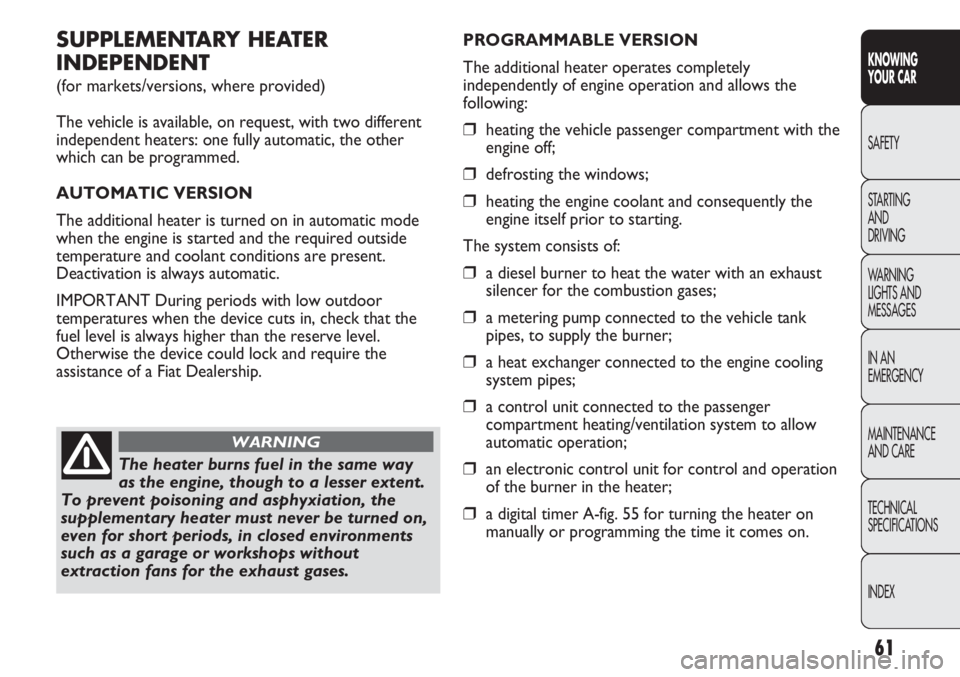
61
KNOWING
YOUR CAR
SAFETY
STARTING
AND
DRIVING
WARNING
LIGHTS AND
MESSAGES
IN AN
EMERGENCY
MAINTENANCE
AND CARE
TECHNICAL
SPECIFICATIONS
INDEX
SUPPLEMENTARY HEATER
INDEPENDENT
(for markets/versions, where provided)
The vehicle is available, on request, with two different
independent heaters: one fully automatic, the other
which can be programmed.
AUTOMATIC VERSION
The additional heater is turned on in automatic mode
when the engine is started and the required outside
temperature and coolant conditions are present.
Deactivation is always automatic.
IMPORTANT During periods with low outdoor
temperatures when the device cuts in, check that the
fuel level is always higher than the reserve level.
Otherwise the device could lock and require the
assistance of a Fiat Dealership.
The heater burns fuel in the same way
as the engine, though to a lesser extent.
To prevent poisoning and asphyxiation, the
supplementary heater must never be turned on,
even for short periods, in closed environments
such as a garage or workshops without
extraction fans for the exhaust gases.
WARNING
PROGRAMMABLE VERSION
The additional heater operates completely
independently of engine operation and allows the
following:
❒heating the vehicle passenger compartment with the
engine off;
❒defrosting the windows;
❒heating the engine coolant and consequently the
engine itself prior to starting.
The system consists of:
❒a diesel burner to heat the water with an exhaust
silencer for the combustion gases;
❒a metering pump connected to the vehicle tank
pipes, to supply the burner;
❒a heat exchanger connected to the engine cooling
system pipes;
❒a control unit connected to the passenger
compartment heating/ventilation system to allow
automatic operation;
❒an electronic control unit for control and operation
of the burner in the heater;
❒a digital timer A-fig. 55 for turning the heater on
manually or programming the time it comes on.
Page 66 of 287
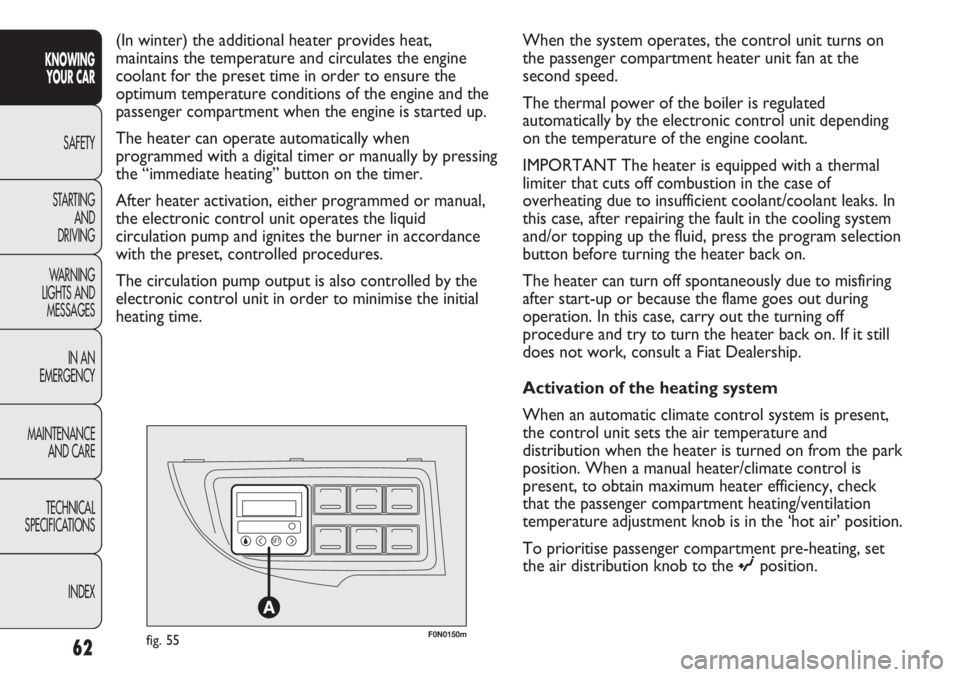
62
KNOWING
YOUR CAR
SAFETY
STARTING
AND
DRIVING
WARNING
LIGHTS AND
MESSAGES
IN AN
EMERGENCY
MAINTENANCE
AND CARE
TECHNICAL
SPECIFICATIONS
INDEX
F0N0150mfig. 55
(In winter) the additional heater provides heat,
maintains the temperature and circulates the engine
coolant for the preset time in order to ensure the
optimum temperature conditions of the engine and the
passenger compartment when the engine is started up.
The heater can operate automatically when
programmed with a digital timer or manually by pressing
the “immediate heating” button on the timer.
After heater activation, either programmed or manual,
the electronic control unit operates the liquid
circulation pump and ignites the burner in accordance
with the preset, controlled procedures.
The circulation pump output is also controlled by the
electronic control unit in order to minimise the initial
heating time. When the system operates, the control unit turns on
the passenger compartment heater unit fan at the
second speed.
The thermal power of the boiler is regulated
automatically by the electronic control unit depending
on the temperature of the engine coolant.
IMPORTANT The heater is equipped with a thermal
limiter that cuts off combustion in the case of
overheating due to insufficient coolant/coolant leaks. In
this case, after repairing the fault in the cooling system
and/or topping up the fluid, press the program selection
button before turning the heater back on.
The heater can turn off spontaneously due to misfiring
after start-up or because the flame goes out during
operation. In this case, carry out the turning off
procedure and try to turn the heater back on. If it still
does not work, consult a Fiat Dealership.
Activation of the heating system
When an automatic climate control system is present,
the control unit sets the air temperature and
distribution when the heater is turned on from the park
position. When a manual heater/climate control is
present, to obtain maximum heater efficiency, check
that the passenger compartment heating/ventilation
temperature adjustment knob is in the ‘hot air’ position.
To prioritise passenger compartment pre-heating, set
the air distribution knob to the
©position.